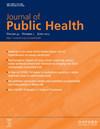32 个中低收入国家 40 万例住院分娩中新生儿死亡率与未称重分娩之间的关系
IF 3.6
4区 医学
Q1 PUBLIC, ENVIRONMENTAL & OCCUPATIONAL HEALTH
引用次数: 0
摘要
背景 低出生体重儿的新生儿死亡风险较高。因此,所有住院分娩的婴儿都应称重,以确定适当的护理。出生时未称重(NWB)的新生儿的死亡风险尚不清楚。方法 本文利用 32 个中低收入国家人口与健康调查中收集的 401 712 例住院分娩数据,采用 logit 回归模型比较了未称重新生儿与其他新生儿的死亡几率。结果 在汇总样本中,2.3%的新生儿在新生儿期死亡,其中 12% 为非白血病新生儿。与正常出生体重儿相比,非正常出生体重新生儿的死亡风险较高(调整后赔率比 [AOR] 5.8,95% CI:5.3, 6.5)。与正常出生体重儿相比,非正常出生体重儿的死亡风险更高。与新生儿体重不足相关的新生儿死亡风险因国家而异,阿富汗的 AOR 为 2.1(95% CI:1.22, 3.8),加蓬为 94(95% CI:22, 215)。在汇总样本中,12% 的非战斗性脑损伤患儿占新生儿死亡总数的 37%。结论 非孕期婴儿与新生儿死亡率之间的关联可能表明,有必要关注与新生儿护理相关的机构的质量。然而,要确定因果关系,还需要进一步的研究。急诊或死亡也可能导致新生儿腹泻。本文章由计算机程序翻译,如有差异,请以英文原文为准。
Association between neonatal mortality and births not weighed among 400 thousand institutional deliveries in 32 low- and middle-income countries
Background Low birthweight (LBW) children have a higher risk of neonatal mortality. All institutional deliveries, therefore, should be weighed to determine appropriate care. Mortality risk for newborns who are not weighed at birth (NWB) is unknown. Methods This paper used logit regression models to compare the odds of death for NWB neonates to that of other neonates using data on 401 712 institutional births collected in Demographic and Health Surveys from 32 low- and middle-income countries. Results In the pooled sample, 2.3% died in the neonatal period and 12% were NWB. NWB neonates had a high risk of mortality compared to normal birthweight children (Adjusted odds ratio [AOR] 5.8, 95% CI: 5.3, 6.5). The mortality risk associated with NWB was higher than for LBW. The neonatal mortality risk associated with NWB varied across countries from AOR of 2.1 (95% CI: 1.22, 3.8) in Afghanistan to 94 (95% CI: 22, 215) in Gabon. In the pooled sample, the 12% of children who were NWB accounted for 37% of all neonatal deaths. Conclusions The association between NWB and neonatal mortality may suggest a need to focus on the quality of institutions related to newborn care. However, further studies are needed to determine causality. A health emergency or death may also cause NWB.
求助全文
通过发布文献求助,成功后即可免费获取论文全文。
去求助
来源期刊

Journal of Public Health
医学-公共卫生、环境卫生与职业卫生
CiteScore
7.40
自引率
2.30%
发文量
120
审稿时长
6-12 weeks
期刊介绍:
Previous Title Zeitschrift für Gesundheitswissenschaften, Previous Print ISSN 0943-1853, Previous Online ISSN 1613-2238.
The Journal of Public Health: From Theory to Practice is an interdisciplinary publication for the discussion and debate of international public health issues, with a focus on European affairs. It describes the social and individual factors determining the basic conditions of public health, analyzing causal interrelations, and offering a scientifically sound rationale for personal, social and political measures of intervention. Coverage includes contributions from epidemiology, health economics, environmental health, management, social sciences, ethics, and law.
ISSN: 2198-1833 (Print) 1613-2238 (Online)
 求助内容:
求助内容: 应助结果提醒方式:
应助结果提醒方式:


